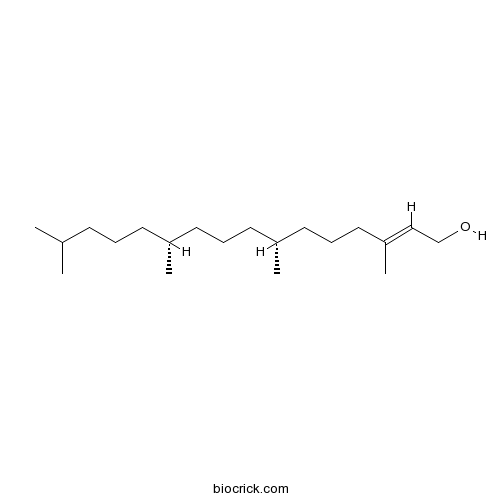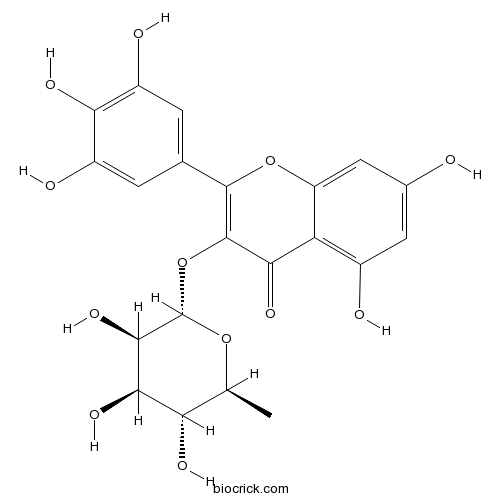Toona sinensis
Toona sinensis
1. The products in our compound library are selected from thousands of unique natural products; 2. It has the characteristics of diverse structure, diverse sources and wide coverage of activities; 3. Provide information on the activity of products from major journals, patents and research reports around the world, providing theoretical direction and research basis for further research and screening; 4. Free combination according to the type, source, target and disease of natural product; 5. The compound powder is placed in a covered tube and then discharged into a 10 x 10 cryostat; 6. Transport in ice pack or dry ice pack. Please store it at -20 °C as soon as possible after receiving the product, and use it as soon as possible after opening.
Natural products/compounds from Toona sinensis
- Cat.No. Product Name CAS Number COA
-
BCN1673
Phytol150-86-7
Instructions

-
BCN1136
Myricitrin17912-87-7
Instructions

-
BCN5549
Astragalin480-10-4
Instructions

-
BCN5459
Nerolidol7212-44-4
Instructions

-
BCN6326
(-)-Epigallocatechin gallate989-51-5
Instructions

Responses of soil nutrients and microbial communities to three restoration strategies in a karst area, southwest China.[Pubmed: 29197267]
Ecological restoration is widespread in the karst region, southwest China, but the impacts of different restoration strategies on soil fertility indices have rarely been compared. Here soil nutrients and microbial communities were measured 16 years after agricultural abandonment in a karst area, southwest China. Three restoration strategies were included, i.e., i) restoration with an economic tree species Toona sinensis (TS), ii) restoration with Guimu-1 hybrid elephant grass (GG), iii) restoration with a combination of Zenia insignis and Guimu-1 hybrid elephant grass (ZG). Cropland under maize-soybean rotation (CR) was used as reference. Soil organic carbon level was more than doubled in TS, and that in GG and ZG was elevated by about 50% relative to CR. Soil total nitrogen concentration in GG was not significantly different from CR, but that in TS and ZG was increased by 93% and 55% relative to CR. Similar to nitrogen, soil total phosphorus concentration in GG was not changed relative to CR, but that in TS and ZG were significantly increased. Microbial biomass carbon and nitrogen concentrations were significantly increased in TS and GG by 124% and 82%, respectively, compared to CR, but those in ZG and CR were similar. The abundance of total PLFAs (phospholipid fatty acids) was significantly increased by 55-69% following agricultural abandonment, and there was no significant difference among the three restoration strategies. The patterns of the other microbial groups and the ratio of fungal to bacterial (F:B) PLFAs were largely similar to that of total PLFAs. Soil organic carbon was identified as the primary factor affecting the abundance of soil microbial communities. Our findings suggest that the three restoration strategies, particularly TS are efficient in improving soil fertility.
Quercetrin from Toona sinensis leaves induces cell cycle arrest and apoptosis via enhancement of oxidative stress in human colorectal cancer SW620 cells.[Pubmed: 29039609]
Finding effective strategies against colorectal cancer (CRC) is still an emergent health problem. In the present study, we investigated the anticancer activity of quercetrin from Toona sinensis leaves (QTL) and explored the underlying mechanism in human CRC cell line SW620. The cells were treated with various concentrations of QTL and the cytotoxic effects of QTL were determined using the MTT assay. Apoptosis and cell cycle status were detected by flow cytometry. Reactive oxygen species (ROS) levels and mitochondrial membrane potential (∆Ψm) were assessed using DCF-DA and JC-1 fluorescence spectrophotometry, respectively. Western blot analysis was used to quantify the expression of apoptosis‑related proteins. RT-PCR was applied to determine the mRNA levels of glutathione peroxidase (GPx) and catalase (CAT). QTL exhibited growth inhibitory effects and caused cell cycle arrest in the G2/M phase, which was accompanied by increased expression of p53 and p21 proteins. QTL promoted apoptosis which was consistent with the upregulated expression of Bax, cytochrome c, caspase-9, Apaf-1 and caspase-3. In addition, QTL induced the loss of mitochondrial membrane potential and triggered ROS generation, as revealed by the downregulated mRNA expression and enzymatic activity of GPx and CAT. Furthermore, both N‑acetyl cysteine (NAC) and GSH attenuated the QTL-induced growth inhibition observed in SW620 cells along with the increase of ROS levels. These findings revealed that QTL inhibited the growth of CRC cells and facilitated apoptosis by enhancing oxidative stress. QTL may therefore have potential for use in CRC chemotherapy.
Extraction of proteins and preliminary characterization of physicochemical properties in Toona sinensis fruit.[Pubmed: 28198502]
We investigated the extraction of Toona sinensis fruit proteins and preliminarily characterized their physicochemical properties. The results showed that optimal extraction occurred under conditions of pH 10.5, a duration of 40 min, a liquid-to-solid ratio of 25:1, and a temperature of 40°C by an orthogonal design using T. sinensis fruit protein as the index and single factor. The total nitrogen content was 13.8 g/100 g and included 17 different amino acids. The glutamate level was highest at 35.37%, followed by arginine at 15.31%. The isoelectric point of T. sinensis fruit protein was between 6.8 and 10.0 with a typical absorption peak by infrared chromatography. Three protein bands were analyzed using SDS-polyacrylamide gel electrophoresis, with relative molecular weights of 55, 51, and 22 kDa. This study provides a theoretical basis for the comprehensive utilization of T. sinensis fruit by further investigating the biological activity of its proteins.
The Fractionated Toona sinensis Leaf Extract Induces Apoptosis of Human Osteosarcoma Cells and Inhibits Tumor Growth in a Murine Xenograft Model.[Pubmed: 27879376]
Osteosarcoma is a malignant bone tumor prevalent in adolescents with poor prognosis. Toona sinensis showed potent antiproliferation effect on lung, melatonin, ovary, colon, and liver cancers. However, the effects of the species on osteosarcoma cells are rarely investigated.
Lactam Triterpenoids from the Bark of Toona sinensis.[Pubmed: 27757925]
Three new limonoid-type triterpenoids, namely toonasins A-C (1-3) with a rare lactam E ring, along with six known compounds (4-9) were isolated from the barks of Toona sinensis. The structures of new compounds were elucidated by interpretation of spectroscopic data, and the relative configuration of compound 1 was further characterized by X-ray crystallographic analyses. The isolated compounds were evaluated for their cytotoxic activities against five human tumor cell lines (HL-60, SMMC-7721, A-549, MCF-7 and SW480), and compounds 3 and 5 showed weak cytotoxicities.
An efficient method for decoloration of polysaccharides from the sprouts of Toona sinensis (A. Juss.) Roem by anion exchange macroporous resins.[Pubmed: 27664659]
An efficient decoloration method for polysaccharides from the sprouts of Toona sinensis (A. Juss.) Roem (PSTS) by anion exchange macroporous resins (AEMR) was investigated in the present paper. The results suggested that D941 resin offered better decoloration efficiency than other tested resins. Based on single-factor experiments, the optimal decoloration parameters of D941 resin were obtained as follows: temperature of 45°C, sample initial concentration of 30mg/ml, pH value of 8.5, static decoloration time of 90min, dynamic decoloration processing volume of 5.5BV with the flow rate of 2BV/h. Decoloration ratio, PSTS recovery ratio and selectivity coefficient were 91.94±1.23%, 90.05±2.35% and 10.92±0.63, respectively. Most of pigment impurities were successfully removed from PSTS solutions after treated by D941 resin, and there was no significant difference in carbohydrate concentration, characteristic groups and molecular weight. Compared with H2O2 oxidation and activated carbon adsorption, this developed method is superior.
Genetic diversity of Toona sinensis Roem in China revealed by ISSR and SRAP markers.[Pubmed: 27525892]
Toona sinensis Roem has an important value as a type of traditional vegetable and Chinese medicinal herb, and is also a valuable source of wood in China. In this study, we used the inter-simple sequence repeat (ISSR) and sequence-related amplified polymorphism (SRAP) markers to assess the level and pattern of genetic diversity in five domesticated T. sinensis populations in China. Our results indicated a relatively low level of genetic diversity both at species (Hs = 0.1662, 0.2098, respectively) and population levels (Hs = 0.0978, 0.1145, respectively). Molecular variance analyses revealed a relatively high degree of differentiation among populations (GST = 0.3901, 0.4498), and low levels of gene flow (Nm = 0.7816 and 0.6116). We divided the five populations into two groups by cluster analysis: group one consists of populations collected from the south part of China (e.g., Yuxi, Yunan Province and Zuanjiang, Chongqing Municipality), and group two contains those cultivated in north part of China (e.g., Hengshui, Hebei Province, Jinan and Rizhao, Shandong Province). The correlation of genetic relationships among populations fits well with their geographical distribution (Mantel test; r = 0.7236 and 0.6789, respectively). Asexual propagation, limited gene flow and geographic isolation are most likely the key factors associated with the observed genetic structure of T. sinensis grown in China. The present study indicated that both ISSR and SRAP markers were effective and reliable for assessing the degree of T. sinensis genetic variations.


